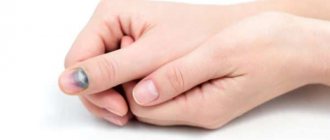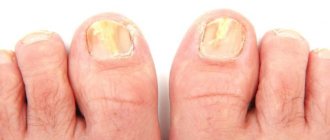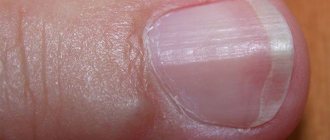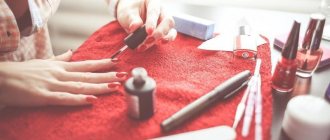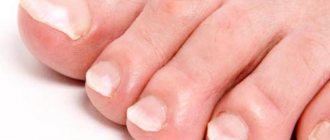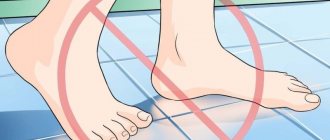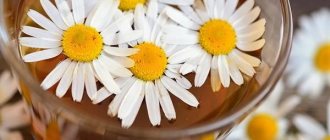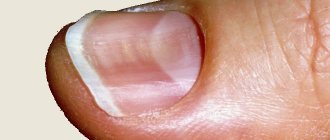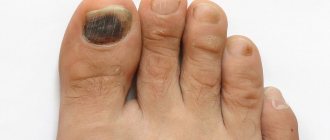Color change
Normally, a child’s nails are a soft pink color with a pronounced whitish hole at the base. What factors change their color? What might a certain color indicate?
White
Sometimes white spots appear on the child's fingernails or toenails. This condition is medically called leukonychia.
There are several forms of it:
- total, the entire nail plate becomes white;
- stripe-like, transverse white stripes are formed;
- dotted, white dots appear on the child’s nails;
- limited, manifests itself in the form of elongated spots of small size.
People believe that white spots occur due to excessive intake of vitamins and minerals, but in fact this is not the case. The causes of white spots on a child’s nails are long-term minor injuries, mechanical damage to the growth zone, and the habit of biting nails. Such changes may appear on your feet due to improperly selected shoes. White spots on a child's nails may be a manifestation of a fungal infection (onychomycosis).
Among systemic diseases, leukonychia is caused by iron deficiency anemia, pathologies of the liver, heart, intoxication, impaired protein digestion, psoriasis, and eczema.
The white spots and stripes on a child’s nails themselves do not require treatment.
In most cases, this is a temporary cosmetic defect that disappears as the nail plate grows. If they appear again, you need to consult a doctor, undergo an examination, and find out their cause.
Yellow
Yellow color is almost always a sign of onychomycosis. This disease is much less common in children than in adults. But it cannot be ruled out. Another yellow color is characteristic of psoriasis.
In addition, the yellow color of a child’s nails is provoked by abnormalities in the liver with impaired bilirubin metabolism, jaundice, pathologies of the endocrine and lymphatic systems, and chronic inflammation of the mucous membrane of the paranasal sinuses.
Red
The red coloration of a child's nails is associated with inflammatory processes in the soft tissues of the nail bed, impaired blood flow in the capillaries, and dilation of small vessels. It is often observed with high temperature and fever.
Red or brown stripes or dashes are the consequences of damage to small vessels under the nail plate that occur as a result of injury.
Black
One of the common causes of black color is household injuries. For example, if a child pinches a finger with a nail in an interior or entrance door. After a severe bruise, swelling occurs, hemorrhage into the soft tissues of the nail bed, and a hematoma forms. After 10 hours, the child's nail turns black or blue, depending on the severity of the injury.
To help your baby, immediately after an injury, apply a cold compress to the sore spot or place the injured finger under a stream of cold water from the tap.
The resulting hematoma resolves within 4 to 6 weeks.
What to do if nails peel while breastfeeding: problems with nails for mother and baby
Problems with the health and condition of nails after childbirth can arise for both mother and baby. It is important to correctly recognize the causes and understand why this happens, choose treatment and procedures. Let's look at what to do in the first and second cases.
If the nails of a nursing mother are peeling
Pregnancy and childbirth are not a reason to give up caring for beauty. Many mothers face the problem of splitting and deterioration in the appearance of their nails.
The reasons for this lie in the lack of vitamins, especially calcium. It is known that in the first six months after childbirth, a woman loses about 5% of this useful element.
But calcium during breastfeeding is necessary for the growth and strengthening of nails and bones, teeth and hair.
The mineral forms the bone skeleton and has a positive effect on the development of infants. Calcium will help the nursing mother’s body recover faster and return to its previous shape.
What to do if there is not enough calcium in the body?
First of all, the breastfeeding diet must include foods containing calcium. These are dairy products, which include cheese, cottage cheese, yogurt and milk.
However, be careful, as cow protein sometimes causes allergies in infants. In addition, sesame seeds, almonds, green vegetables, dried figs and beans contain calcium. These products are safe for nursing mothers and babies when consumed in moderation.
The daily calcium requirement for breastfeeding is 1.5 grams.
During lactation, you can take multivitamin complexes for nursing.
Calcium gluconate and Kalcemin, Elevit and Pregnavit, Alphabet Mom's Health and others will help compensate for the lack of vitamins and minerals.
However, before using any product, carefully read the instructions, study the composition and dosage, contraindications and side effects. It is advisable to consult a doctor.
Many mothers are interested in how to care for their nails after childbirth. Doctors do not recommend visiting nail salons, as it is easy to pick up infections and harmful bacteria there. Therefore, it is better to perform nail care procedures at home. Let's look at how to strengthen your nails at home.
Homemade nail care products for moms
- If you have weakened nails, protect your hands from exposure to aggressive factors. Use gloves when handling detergents, laundry detergents and bleaches;
- Use hypoallergenic protective and nourishing creams for the skin of your hands and nails;
- Lemon juice will help remove yellowness and strengthen your nails. Just rub them daily with a slice of lemon;
- An effective remedy is salt baths for hands using sea salt;
- Soda baths will also help. To prepare, simply pour one tablespoon of baking soda into a glass of warm water and mix thoroughly. Keep your fingers in the solution for several minutes;
- As a bath and massage oil for the hands, use a solution of olive oil, five drops of vitamin A and five drops of lemon juice;
- Don't forget about proper nutrition. The diet of a nursing mother should be varied, rich and nutritious. It should include vitamins A, B and E, calcium, silicon and iron. But remember that your food intake should be reasonable! Proper nutrition will not only restore beauty and health to the mother, but also improve lactation and ensure normal growth and development of the baby;
- Remember that manicure should not be harsh and aggressive! How to properly do a manicure while breastfeeding, read the link https://vskormi.ru/mama/mojno-li-krasit-nogti-pri-grudnom-vskarmlivanii/;
- Before doing a manicure, thoroughly disinfect each tool with hydrogen peroxide or alcohol;
- Toxic substances contained in nail polish and nail polish remover penetrate into the mother's blood and milk through the respiratory tract. To reduce the concentration of toxic substances, use a gauze bandage on your face and do not lean close to your nails during the procedure. You can only do a manicure in a well-ventilated area!
- Choose only high-quality varnish. It is important that the child is in another room during the procedure and does not inhale harmful fumes. The interval between painting and feeding should be 2-3 hours;
- If the varnish peels off, remove the coating immediately, as your baby may accidentally lick or swallow varnish particles!;
- Use nail polish remover without acetone.
If your baby's nails are peeling
It is important to monitor the baby’s condition, including external changes. After all, such changes may indicate various disorders in the functioning of the child’s body. You need to notice deviations in time and understand why this happened. And then, depending on the reason, take any action.
There are various reasons that explain why a child’s nails peel. These include:
- Mechanical damage and finger injuries. Even a slight bruise or blow can lead to deterioration of the condition of the nails. In this case, the color of the nail changes, becoming blue, purple, and sometimes even black;
- Toenails often become split due to uncomfortable and tight shoes that rub;
- Lack of minerals and vitamins, especially calcium and iron, leads to deformed nails. Due to vitamin deficiency, the nail begins to split at the base, often changes color and becomes yellow, sometimes covered with white spots;
- A fungal infection is an alarm bell for mom and dad. The infection usually affects the toenails. The surface of the nails peels off heavily and becomes rough, sometimes thickening. If you find a fungus in your baby, consult a doctor immediately!
- The baby constantly sucks his fingers or bites his nails. The reasons for this behavior lie in stress, internal experiences and even mental disorders. In this situation, bad habits are often accompanied by sleep disturbances and insomnia, restless behavior and loss of appetite;
- Impaired metabolism, anemia and disorders of the adrenal glands can also cause dissection. In case of such problems, it is necessary to undergo a medical examination.
When you find out why your baby’s nails are splitting, you can begin treatment. First of all, you need to eliminate the reasons that led to this problem. Some can be dealt with at home. However, if you are in doubt about the cause or if the defect is serious, contact a specialist! Self-medication will only worsen the situation and lead to new diseases.
How to help a baby
If a vitamin deficiency is detected in a child, special children's multivitamin complexes are prescribed. For example, Pikovit or Prengavit. Children are often prescribed nail treatment with oils containing vitamins A and E, as well as medicinal baths with warm vegetable oil, lemon juice and iodine.
It is important to monitor your baby's nutrition. The diet should include foods rich in calcium and iron. These are broccoli, green apples, dairy products. If the baby has not yet switched to complementary foods, these products should be included in the mother’s menu.
If fungus is detected, be sure to contact a specialist. He will select the right treatment, the course of which is 2-4 months, depending on the stage of the disease. At this time, it is important to disinfect and iron the child’s things with a hot iron to avoid spreading the fungus and infecting other family members.
data-matched-content-rows-num=”9, 3″ data-matched-content-columns-num=”1, 2″ data-matched-content-ui-type=”image_stacked”
Source: https://vskormi.ru/mama/sloyatsya-nogti-u-mami-i-grudnichka/
Change of structure
The surface of the nail plate is normally flat and smooth to the touch.
But under certain physiological or pathological conditions, relief stripes, pinpoint depressions, bulges, and grooves appear on it. Why does this happen, and what violations does it indicate?
Point depressions
Dotted depressions on the nail plate look as if its surface was poked with a needle. These multiple pits are called thimble syndrome. They are a characteristic sign of psoriasis. Also, pinpoint depressions can be associated with skin diseases (eczema, dermatosis, infections), alopecia areata (hair loss).
In infants, pinpoint dents on the nail plate are considered a physiological norm; as the baby grows older, they disappear on their own.
Transverse grooves
Transverse relief stripes on a child’s nails are called Bo’s lines. They are lines up to 1 mm deep, not different in color from a healthy nail plate. They are formed due to damage to the nail matrix (the place where the nail is formed). Their cause may be a lack of nutrients, metabolic disorders, mechanical injuries, impacts in the area of the hole, or taking certain medications. In children, Beau's lines appear after a high fever.
In infants, Bo lines are considered the physiological norm. They appear between 4 and 14 weeks of age and then disappear as the nail plate grows.
Their formation is associated with physiological changes and restructuring in the child’s body during childbirth.
Longitudinal grooves
Longitudinal or vertical stripes on a child’s nails are usually not dangerous. They look like parallel grooves running from the cuticle to the end of the free edge of the nail plate. Upon closer examination at close range in good lighting, you can see that every person has them.
If the longitudinal stripes are strongly pronounced, then this indicates a lack of B vitamins, zinc, iron, magnesium, and mechanical damage to the nail matrix.
If vertical stripes are combined with discoloration, loss of shine, brittleness and deformation of the child's nail, you should consult a doctor. This may signal chronic diseases of the respiratory tract, peripheral blood vessels, psoriasis, iron deficiency anemia, and lichen planus.
Why fingernails peel: causes and treatment at home
Well-groomed, beautiful nails are a sign not only of timely care for your hands, but also of a healthy body.
If your fingernails are peeling, there is a reason to think about your condition. This phenomenon often acts as a reaction to the occurrence of various pathological processes in the body.
To choose the right treatment, it is first recommended to find out the main cause of the dissection.
This phenomenon can occur in adults, pregnant women, and children, which also determines the nature of the treatment.
Home care tips and ways to fix the problem will help you get your hands in order.
Reasons why fingernails peel
The main reason why nails peel in an adult is a lack of vitamins. Iron and calcium are two main components responsible for the normal development of the nail plate.
Seasonal vitamin deficiency or constant lack of vitamins will be the main prerequisite for stratification.
Let's take a closer look at the list of reasons contributing to this problem:
- Wrong diet. People who do not plan their menu correctly or adhere to strict dietary restrictions may encounter a similar problem.
It is based on the same lack of vitamins that do not enter the body with foods. In this case, it is recommended to drink a calcium-based vitamin complex, as well as diversify your diet with healthy foods. - Diseases. This includes diseases associated with metabolic disorders.
It is also worth highlighting fungal infections of the nail plate separately. Constant depression, bad mood, poor circulation and decreased immunity - all this affects the structure of the nail plate. - Poor quality cosmetics. Do your nails break and crumble?
Cosmetics from unscrupulous manufacturers are to blame. You shouldn’t skimp on your health; it’s better to overpay a little, but give preference to trusted manufacturers of varnishes and enamels. - Illiterate hand care. Cosmetologists do not recommend filing the plate while wet, cutting it off with ordinary scissors, or removing the varnish with acetone.
All these mistakes lead to violations and layers.
Often the problem occurs after a varnish that was of poor quality or was used after the expiration date.
When choosing cosmetics, carefully study the reviews and the effect of the composition on the nail plate.
What to do if you crumble during pregnancy
The most common problem in pregnant women is nail plate disorders.
This phenomenon is not accidental, because during the period of bearing a baby, the female body is completely rebuilt, the hormonal background changes.
Calcium deficiency also causes nails to begin to crumble.
Let's answer the question of what to do during pregnancy and how to treat nails:
- Hand massage. To keep your nails looking well-groomed, you need to monitor their condition weekly.
To do this, it is recommended to use a special moisturizing cream for hands and nails based on herbal ingredients. Massage can be done with essential oils, as well as using special products based on calcium and silicone. - Lemon juice. Squeeze a little juice from the citrus and periodically rub it into the nail plate with massaging movements.
This harmless method helps if your nails crumble and break badly. - Vitamin A. The healing component can be added to the cream or masks can be made based on it.
You can add a little olive oil to create a rich base to moisturize and nourish the plate. - Soda baths. Soda-based baths will help strengthen and recover from the problem.
This method is especially helpful for crumbling nails on the big toe or toes. To 1 tablespoon of soda add 15 drops of iodine and a little water. Wipe the nail plate with the solution several times a week. - Additional hand protection. When washing by hand, as well as when washing dishes with chemicals, it is recommended to wear protective rubber gloves.
Pregnant women are not recommended to take pills to restore nails, as they can negatively affect the development of the fetus.
Important! Do not forget about proper nutrition: it is recommended to increase the amount of liver, fresh herbs, butter, tomatoes and carrots.
It will also be useful to introduce cabbage, wheat and egg yolk into the diet; by the way, it is used as a medicinal ingredient for masks in its raw form.
A child’s nails are peeling: the opinion of Dr. Komarovsky
Changes in a baby's appearance should always worry a caring parent.
Regardless of how old the child is - 2 years old or a baby, the problem of peeling nails occurs at any age. Pediatrician Komarovsky has an opinion on this matter.
Note! The doctor claims that this phenomenon occurs for several reasons.
If parents are unable to figure out the cause of the problem on their own, they should contact a specialist.
Let's consider what reasons Dr. Komarovsky identifies that explain why a child's nails peel:
| Cause | Description |
| Mechanical damage to fingers | The separation may be due to the fact that the baby accidentally hit his finger, as a result of which the nail turned blue and began to peel off. |
| Avitaminosis | Delamination at the base of the nail indicates a lack of calcium, iron, and gelatin. To make up for the deficiency, it is recommended to take vitamins and make masks according to folk recipes |
| Fungus | If you suspect an infection, it is recommended not to hesitate and go to the doctor for examination |
| Stress | A violation of the baby’s normal psychological state can provoke his desire to bite his nails, which affects the quality of the nail plate. |
| Diseases | Diseases of the stomach, intestines, endocrine system, as well as chronic pathologies can cause dissection |
Delamination
Quite often, parents are faced with the fact that their child’s nails peel and break. Why is this happening?
This deviation causes:
- improper cutting of nails;
- lack of microelements, vitamins (vitamin A, E, B2, calcium, phosphorus, magnesium, zinc);
- mechanical damage. For example, nails on the hands peel if the child bites them or sucks fingers, on the feet - if he wears shoes that rub or squeeze the tips of the toes;
- health problems (iron deficiency anemia, adrenal dysfunction, onychomycosis).
In most cases, correction of nutrition, taking vitamin-mineral complexes, and rubbing vegetable oils rich in vitamins A and E into the nail plate helps to cope with delamination.
But if its cause is health problems, examination and tests will be needed.
Treatment of psychological diseases
If the reason for splitting nails is that the child is biting them due to stress, then he should be taken to a psychologist. In addition, the atmosphere in the family should be friendly. It is also often recommended to apply a special bitter varnish to the baby’s nails. After this, he is unlikely to want to put his fingers in his mouth again.
You must monitor the child’s emotional state, do everything possible to ensure that it is stable and that anxiety does not make itself felt. Try to spend more time with your baby, perhaps he lacks your attention.
Nail plate separation
It is not uncommon for a child’s fingernails or toenails to peel off. Such an unpleasant picture frightens parents, because they do not understand what this is connected with.
Separation of the nail from the bed is called onycholysis. Its cause in 60% of cases is injury. If the baby hits, bruises, or presses the upper phalanx of the finger, the nutrition of the nail and adhesion to the nail bed are disrupted. Voids are formed, over which the nail becomes opaque and yellow.
In young children, nails can peel off even due to minor trauma, because their nail plates are very thin and soft.
In the event of an accidental injury, the child’s nails peel off only on the injured finger. If they come off on all fingers, then the reason is most likely that the baby is gnawing on them. This bad habit often causes parents to feel as if their child’s nails are not growing.
If this problem bothers you, keep an eye on your baby. Explain to him that this cannot be done. You may need the help of a psychologist to get rid of it.
Other factors that cause children's nails to peel include:
- fungal infection;
- contact of the nail plate with aggressive chemicals and household chemicals;
- purulent inflammation of the periungual folds;
- recent infectious diseases (enteroviral infection);
- disturbance of blood supply and nutrition of the extremities;
- systemic diseases (hyperkeratosis, psoriasis, eczema);
- taking certain medications.
If a child’s nail comes off as a result of injury, then after the damaged nail plate is peeled off, a new healthy nail will soon grow. The main thing is to ensure that no infection occurs during this period.
If redness or inflammation occurs, you should consult a doctor.
How to help a baby
If a vitamin deficiency is detected in a child, special children's multivitamin complexes are prescribed. For example, Pikovit or Prengavit. Children are often prescribed nail treatment with oils containing vitamins A and E, as well as medicinal baths with warm vegetable oil, lemon juice and iodine.
It is important to monitor your baby's nutrition. The diet should include foods rich in calcium and iron. These are broccoli, green apples, dairy products. If the baby has not yet switched to complementary foods, these products should be included in the mother’s menu.
If fungus is detected, be sure to contact a specialist. He will select the right treatment, the course of which is 2-4 months, depending on the stage of the disease. At this time, it is important to disinfect and iron the child’s things with a hot iron to avoid spreading the fungus and infecting other family members.
source: vskormi.ru
Rodent control
Many parents believe that nail biting is just a bad habit. Less common is the child’s constant desire to scratch and scrape everything with his nails. Meanwhile, in the overwhelming majority of cases this is a sign of a serious problem - an emerging neurosis. As practice shows, the occurrence of this scourge is usually associated with the start of kindergarten or school, moving, parental divorce and other stressful situations. Do not scold your child under any circumstances! Moreover, this is absolutely pointless, like many “folk” remedies for fighting a bad habit, such as spreading pepper, mustard on your nails, putting on gloves, bandaging your hands, etc. You may be able to get your child to stop biting his nails, but the external manifestation of neurosis will go inside. And who will guarantee that in a couple of months it will not come out in the form of asthma, gastritis or vegetative-vascular dystonia?! It is better to eliminate the cause by contacting a psychologist. Or simply surround your baby with an atmosphere of love and attention and help him cope with difficult situations. After all, the need to bite your nails has a simple explanation: it is a kind of reflex massage of the fingertips, leading to relaxation and calm. The baby, of course, has no idea about such adult difficulties, but does this, subconsciously feeling how to get rid of stress and oppressive tension.
Dots and mushrooms
Small white dots or longitudinal grooves that appear on the nails are an SOS signal from the body: this means that the baby is lacking vitamins. Which ones exactly should be determined by the pediatrician. After taking the missing substances, the spots usually disappear as soon as a new nail grows.
Serious changes to the nails and the skin around them occur with psoriasis. Pinpoint pits appear, like on a thimble, and the surface becomes rough and pockmarked. Sometimes the nail plate separates from the bed. Often the nails change color (become dull white), configuration, and thicken. Only a dermatologist can determine whether it is psoriasis or a fungus, so do not put off visiting a doctor and do not self-medicate on the advice of grandmothers and friends.
Fortunately, fungal infections of the nail plates in children are rare. However, some caution will not hurt, especially if the child visits the bathhouse or swimming pool. Cracks and wounds on the skin, decreased immunity - and now a fungus multiplies, loving a humid, warm microclimate.
For water procedures, the baby should have special slippers, preferably with thick soles and from which the foot does not hang down. If you still do not rule out the possibility of infection, after the pool, wipe your child’s feet with regular hydrogen peroxide - it will destroy all germs.
To avoid trouble, teach your child to always wear flip-flops, wipe their feet dry after a shower, and never step on a wet floor or stream of dirty water in the shower. When visiting, let the baby wear socks, but you should always refuse other people’s slippers. And strengthen your immune system - a healthy body is not afraid of fungal infections.
